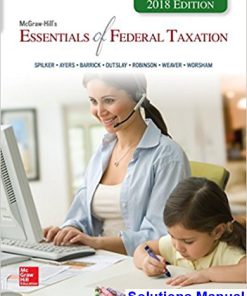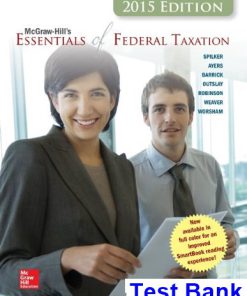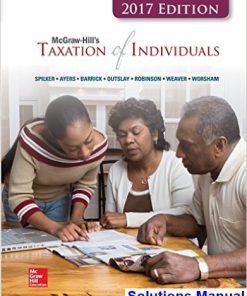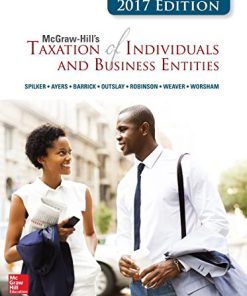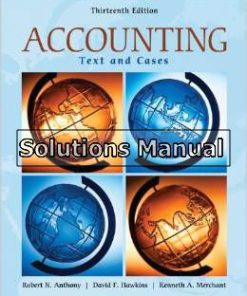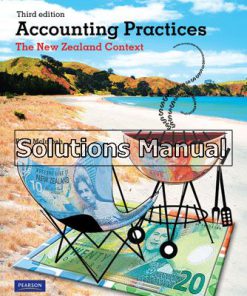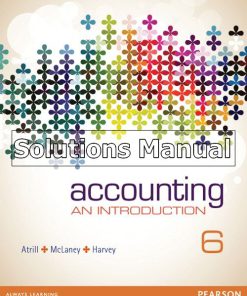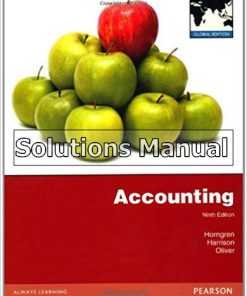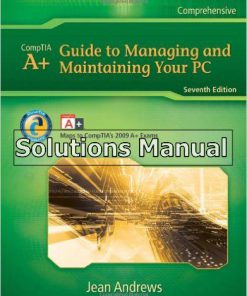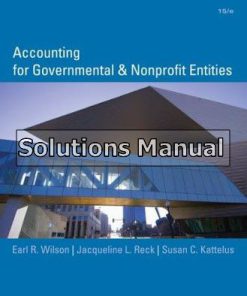$26.50$50.00 (-47%)
In stock
Essentials of Federal Taxation 2017 8th Edition Spilker Solutions Manual.
You may also like
Essentials of Federal Taxation 2017 8th Edition Spilker Solutions Manual

Product details:
- ISBN-10 : 1259730700
- ISBN-13 : 978-1259730702
- Author: John Robinson
McGraw-Hill’s Essentials of Federal Taxation is designed fora one-semester course covering the basics of taxation of individualsand business entities. To facilitate a one-semestercourse McGraw-Hill’s Essentials of Federal Taxation foldsthe key topics from the investments compensation retirementsavings and home ownership chapters in Taxation ofIndividuals into three individual taxation chapters that discussgross income and exclusions for AGI deductions andfrom AGI deductions respectively. The essentials volumealso includes a two-chapter C corporation sequence that usesa life-cycle approach covering corporate formations and thencorporate operations in the first chapter and nonliquidatingand liquidating corporate distributions in the second chapter.This volume is perfect for those teaching a one-semestercourse and for those who struggle to get through the 25-chaptercomprehensive volume.
Table contents:
- Chapter 1: Introduction to Federal Taxation and Understanding the Federal Tax Law
- 1.1: Fundamental Aspects of Federal Taxation
- 1.2: Underlying Rationale of the Federal Income Tax
- 1.3: Basic Tax Concepts
- 1: True-False Questions (27)
- 1: Multiple Choice Questions (16)
- Chapter 2: Tax Research, Practice, and Procedure
- 2.1: Tax Reference Materials
- 2.2: Primary Source Materials
- 2.3: Secondary Source Materials
- 2.4: Research Methodology
- 2.5: Tax Administration
- 2.6: Tax Practice and Procedure
- 2: True-False Questions (64)
- 2: Multiple Choice Questions (54)
- Chapter 3: Individual Taxation–An Overview
- 3.1: Individual Taxation–An Overview
- 3.2: Personal Exemptions
- 3.3: Filing Status and Requirements
- 3: True-False Questions (31)
- 3: Multiple Choice Questions (19)
- Chapter 4: Gross Income
- 4.1: The Concept of Income
- 4.2: Economic Benefit, Constructive Receipt, and Assignment of Income Doctrines
- 4.3: Items Included in Gross Income
- 4.4: Stock Option Plans
- 4: True-False Questions (39)
- 4: Multiple Choice Questions (40)
- Chapter 5: Gross Income–Exclusions
- 5.1: Common Exclusions from Gross Income
- 5.2: Employee Benefits
- 5: True-False Questions (21)
- 5: Multiple Choice Questions (40)
- Chapter 6: Deductions: General Concepts and Trade or Business Deductions
- 6.1: Categories of Allowable Deductions
- 6.2: Trade or Business Deductions
- 6.3: Expenses Incurred for the Production of Income
- 6.4: Deductions for Losses
- 6.5: Other Allowable Deductions “For” AGI
- 6.6: Employee Business Expenses
- 6.7: Limitations on the Deductibility of Expenses
- 6.8: Business Deductions Related to Capital Expenditures
- 6: True-False Questions (50)
- 6: Multiple Choice Questions (60)
- Chapter 7: Deductions: Business/Investment Losses and Passive Activity Losses
- 7.1: Tax Shelters and At-Risk Rules
- 7.2: Passive Activity Loss Rules
- 7.3: Business and Investment Losses
- 7: True-False Questions (30)
- 7: Multiple Choice Questions (30)
- Chapter 8: Deductions: Itemized Deductions
- 8.1: Medical Expenses
- 8.2: Taxes
- 8.3: Interest
- 8.4: Charitable Contributions
- 8.5: Personal Casualty and Theft Losses
- 8.6: Miscellaneous Itemized Deductions
- 8.7: Investment Expenses
- 8: True-False Questions (41)
- 8: Multiple Choice Questions (31)
- Chapter 9: Tax Credits, Prepayments, and Alternate Minimum Tax
- 9.1: Nonrefundable Tax Credits
- 9.2: Refundable Tax Credits
- 9.3: Alternate Minimum Tax
- 9: True-False Questions (47)
- 9: Multiple Choice Questions (35)
- Chapter 10: Property Transactions: Determination of Basis and Gains and Losses
- 10.1: Factors in Determining Gain or Loss
- 10.2: Determination of Basis
- 10: True-False Questions (35)
- 10: Multiple Choice Questions (44)
- Chapter 11: Property Transactions: Nonrecognition of Gains and Losses
- 11.1: Sale of a Personal Residence
- 11.2: Like-Kind Exchanges
- 11.3: Involuntary Conversions
- 11.4: Other Transactions Involving Nonrecognition
- 11: True-False Questions (40)
- 11: Multiple Choice Questions (50)
- Chapter 12: Property Transactions: Treatment of Capital and Section 1231 Assets
- 12.1: Special Rules and Limitations on Transactions
- 12.2: Special Situations in Capital v. Ordinary Treatment
- 12.3: Holding Period
- 12.4: Individual Taxpayers
- 12.5: Special Provisions for Certain Investments
- 12.6: Section 1231 Assets and Procedure
- 12.7: Depreciation Recapture–Section 1245
- 12.8: Depreciation Recapture–Section 1250
- 12.9: Recapture Rules in Other Events
- 12: True-False Questions (56)
- 12: Multiple Choice Questions (52)
- Chapter 13: Tax Accounting
- 13.1: Taxable Income and Tax Liability for Various Entities
- 13.2: Accounting Periods
- 13.3: Change of Accounting Periods
- 13.4: Accounting Methods
- 13.5: Change of Accounting Methods
- 13.6: Inventories
- 13.7: Long-term Contracts
- 13.8: Installment Sales
- 13: True-False Questions (18)
- 13: Multiple Choice Questions (61)
- Chapter 14: Taxation of Corporations–Basic Concepts
- 14.1: Entity Choice
- 14.2: Organization Of and Transfers to a Corporation
- 14.3: Corporate Capital Structure
- 14.4: Determination of Corporate Taxable Income
- 14.5: Determination of Corporate Income Tax Liability
- 14: True-False Questions (22)
- 14: Multiple Choice Questions (62)
- Chapter 15: Corporate Nonliquidating Distributions
- 15.1: Distributions With Respect to Stock
- 15.2: Stock Redemptions
- 15: True-False Questions (20)
- 15: Multiple Choice Questions (43)
- Chapter 16: Corporate Distributions in Complete Liquidations
- 16.1: Complete Liquidations
- 16.2: Effect of Complete Liquidation on Corporations
- 16.3: Effect of Complete Liquidation on Shareholders
- 16.4: Liquidation of Subsidiaries
- 16.5: Stock Purchases Treated as Asset Acquisitions
- 16: True-False Questions (20)
- 16: Multiple Choice Questions (25)
- Chapter 17: Corporate Reorganizations
- 17.1: Types of Corporate Reorganizations
- 17.2: Considerations for Nonrecognition Treatment
- 17.3: Carryover of Tax Attributes
- 17.4: Judicial Requirements
- 17: True-False Questions (20)
- 17: Multiple Choice Questions (25)
- Chapter 18: Accumulated Earnings and Personal Holding Company Taxes
- 18.1: Accumulated Earnings Tax
- 18.2: Personal Holding Company Tax
- 18: True-False Questions (10)
- 18: Multiple Choice Questions (26)
- Chapter 19: Partnerships–Formation and Operation
- 19.1: Definition of a Partnership
- 19.2: Partnership Reporting
- 19.3: Partnership Accounting Concepts
- 19.4: Formation of a Partnership–Contributions Requiring Special Consideration
- 19.5: Formation of a Partnership–Recognition of Gain or Loss
- 19.6: Taxable Year of Partner and Partnership
- 19.7: Operation of the Partnership
- 19.8: Partner-Partnership Transactions
- 19.9: Deductibility of Losses
- 19.10: Termination of Partnership
- 19.11: Family Partnerships
- 19: True-False Questions (27)
- 19: Multiple Choice Questions (49)
- Chapter 20: Partnerships–Distribution, Sales, and Exchanges
- 20.1: Partnership Distributions
- 20.2: Partnership Current Distributions
- 20.3: Partnership Liquidating Distributions
- 20.4: Effect of Liabilities
- 20.5: Disproportionate Distributions–Distribution of “Hot” Assets
- 20.6: Sale of a Partner’s Interest in the Partnership
- 20.7: Partnership Basis Adjustments
- 20.8: Retirement or Death of a Partner
- 20: True-False Questions (20)
- 20: Multiple Choice Questions (40)
- Chapter 21: S Corporations
- 21.1: Selecting the Subchapter S Form
- 21.2: S Corporation Taxation
- 21.3: Treatment of Income, Deductions, and Credits
- 21.4: Treatment of Corporate Distributions
- 21.5: Termination of Election
- 21.6: Operational Rules
- 21: True-False Questions (40)
- 21: Multiple Choice Questions (49)
- Chapter 22: Federal Estate Tax, Federal Gift Tax, and Generation-Skipping Transfer Tax
- 22.1: Impact of Economic Growth and Tax Relief Reconciliation Act of 2001, Tax Relief Act of 2010, and American Taxpayer Relief Act of 2012
- 22.2: Assessment of the 2010 Tax Relief Act
- 22.3: Legal Terms Common to Estates and Trusts
- 22.4: Computation and Payment of Estate Tax
- 22.5: Gross Estate
- 22.6: Conservation Easement
- 22.7: Valuation of Gross Estate
- 22.8: Deductions from the Gross Estate
- 22.9: Federal Gift Tax
- 22.10: Exclusions
- 22.11: Generation-Skipping Transfer (GST) Tax
- 22: True-False Questions (25)
- 22: Multiple Choice Questions (35)
- Chapter 23: Income Taxation of Trusts and Estates
- 23.1: Taxation of Estates
- 23.2: Taxation of Trusts
- 23.3: Federal Income Taxation Scheme–Estates and Trusts
- 23.4: Taxation of Trusts–Special Rules
- 23: True-False Questions (25)
- 23: Multiple Choice Questions (25)
- Chapter 24: Deferred Compensation and Education Savings Plan
- 24.1: Employer-Sponsored Deferred Compensation Plans: “Qualified” and “Nonqualified”
- 24.2: Basic Types of Employer-Sponsored Qualified Retirement Plans
- 24.3: Qualified Plan Requirements
- 24.4: Tax Consequences to Employer and Employee
- 24.5: Common Retirement Plans for Large Businesses
- 24.6: Common Retirement Plans for Small Businesses
- 24.7: Personal Retirement Plans for Working Individuals
- 24.8: Nonqualified Deferred Compensation Plans
- 24.9: Education Savings Vehicles
- 24: True-False Questions (23)
- 24: Multiple Choice Questions (39)
- Chapter 25: Multijurisdictional Taxation: International and State and Local Transactions
- 25.1: State and Local Taxation (SALT)
- 25.2: Limitations on the Power of States and Local Authorities to Impose Taxes
- 25.3: Determining Whether a Nonresident is Subject to a State’s Taxes
- 25.4: Types of Taxes Imposed by States
- 25.5: International Taxation
- 25.6: Sourcing Income
- 25.7: Sourcing Deductions
- 25.8: U.S. Taxation of Foreign Persons
- 25.9: Taxation of U.S. Shareholders Who Own Foreign Corporation Stock
- 25.10: U.S. Taxation of Foreign Income
- 25.11: Corporate Inversions
- 25: True-False Questions (20)
- 25: Multiple Choice Questions (45)
People also search:
essentials of federal income taxation for individuals and business
essentials of federal taxation
jct estimates of federal tax expenditures
8.2 federal taxes
8.2 federal taxes pdf free

